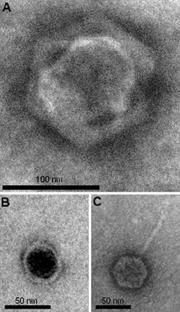First of the parasitic parasites to be discovered in a natural environment points to hidden diversity.
© NatureViruses from Organic lake, including the virophage (bottom left) From reference 1
A genomic survey of the microbial life in an Antarctic lake has revealed a new virophage - a virus that attacks viruses. The discovery suggests that these life forms are more common, and have a larger role in the environment, than was once thought.
An Australian research team found the virophage while surveying the extremely salty Organic Lake in eastern Antarctica. While sequencing the collective genome of microbes living in the surface waters, they discovered the virus, which they dubbed the Organic Lake Virophage (OLV).
The OLV genome was identified nestling within the sequences of phycodnaviruses - a group of giant viruses that attack algae. Evidence of gene exchange, and possible co-evolution, between the two suggests that OLV preys on the phycodnavirus. Although OLV is the dominant virophage in the lake, the work suggests others might be present.
By killing phycodnaviruses, the OLV might allow algae to thrive. Ricardo Cavicchioli, a microbiologist at the University of New South Wales in Sydney, Australia, and his colleagues found that mathematical models of the Organic Lake system that took account of the virophage's toll on its host showed lower algal mortality and more blooms during the lake's two ice-free summer months.
"Our work reveals not only an amazing diversity in microbial life in this lake, but also how little we understand about the complexity of the biological functions at work," says Cavicchioli. The findings are published in the
Proceedings of the National Academies of Science1.
Giant killerAnother virophage described this month has similar ecological effects. The marine Mavirus attacks the giant
Cafeteria roenbergensis virus, which preys on
Cafeteria roenbergensis, one of the world's most widespread species of zooplankton
2.
"The Mavirus is able to rescue the infected zooplankton - which, in a way, confers immunity from infection," says Curtis Suttle, a marine microbiologist at the University of British Columbia in Vancouver, Canada, and leader of the team that discovered the Mavirus.
"We unknowingly had Mavirus in culture with our
Cafeteria system since the early 1990s," says Suttle. But the virophage was not identified until the
Cafeteria genome was sequenced.
The Mavirus genome is similar to DNA sequences called eukaryotic transposons, which insert themselves within the genomes of multicellular organisms such as plants and animals. These 'jumping genes' may be descended from a virophage, says Suttle. "One can imagine evolutionary pressure for hosts to somehow cultivate virophages to protect themselves from infection by giant viruses," he says.
French SputnikThe first virophage, dubbed Sputnik, was discovered in a water-cooling tower in Paris in 2008
3.
"We have been waiting for others to find virophages, to confirm our discovery wasn't an artefact," says Christelle Desnues, a microbiologist at the National Centre of Scientific Research in Marseilles, France, and a member of the team that described Sputnik. She now anticipates "an exponential discovery of virophages".
The hosts of all three known virophages belong to a group of giant viruses known as nucleocytoplasmic large DNA viruses (NCLDV). "NCLDV viruses have large and complex genomes that allow them to incorporate the smaller virophages, something smaller viruses may not be able to do," says Desnues.
The OLV was discovered when Cavicchioli's graduate student, Sheree Yau, noticed that some of the sequences from microbes in Organic Lake were similar to those encoding Sputnik's protein shell. Mavirus has similar sequences, so the trend might help to identify other virophages.
OLV, or virophages like it, may be widespread. The gene for its protein shell matches sequences already found in a host of other aquatic environments, including nearby Ace Lake in Antarctica, a saline lagoon in the Galapagos, an oceanic upwelling zone near the Galapagos, an estuary in New Jersey, and a freshwater lake in Panama.
The high number of matches reflects the fact that the OLV is the first virophage to be found in its natural environment, says Federico Lauro, also a molecular biologist at the University of New South Wales and a co-author of the paper.
Organic Lake, formed 6,000 years ago when sea levels were higher, is a natural laboratory, says Lauro. "These marine-derived lakes are great labs to work in because they are isolated, yet dynamic systems."
References
Yau, S. et al.
Proc. Natl Acad. Sci. USA advance online publication doi: 10.1073/pnas.1018221108 (2011).
Fischer, M. G. et al.
Science advance online publication doi: 10.1126/science.1199412 (2011).
La Scola, B. et al.
Nature 455, 100-104 (2008). | Article | ISI | ChemPort |
Reader Comments
to our Newsletter